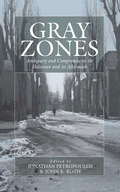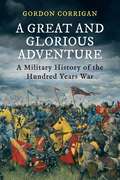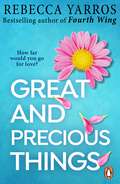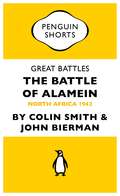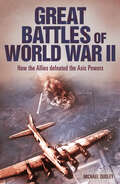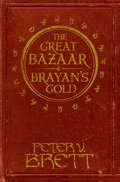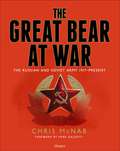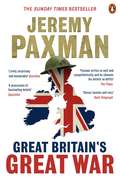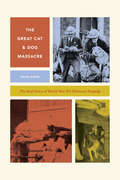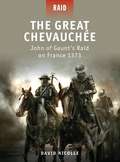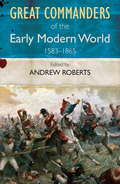- Table View
- List View
Gravelotte-St-Privat 1870: End of the Second Empire (Campaign #21)
by Philipp Elliot-WrightGravelotte-St-Privat was probably the hardest fought of all the battles of the Franco-Prussian War. Attacked by superior Prussian forces from both the First and Second armies, Marshal Bazaine's French Army of the Rhine inflicted heavy casualties on the advancing Prussian's before finally being forced to retreat into the fortress city of Metz. Unable to break out and with no hope of relief Bazaine's army grimly held on to the end of the war. French failure at Gravelotte-St-Privat led directly to their final defeat at Sedan, the collapse of Napoleon III's regime and the proclamation of the German Empire.
Gray Zones: Ambiguity and Compromise in the Holocaust and its Aftermath (War and Genocide #8)
by Jonathan Petropoulos John RothFew essays about the Holocaust are better known or more important than Primo Levi’s reflections on what he called “the gray zone,” a reality in which moral ambiguity and compromise were pronounced. In this volume accomplished Holocaust scholars, among them Raul Hilberg, Gerhard L. Weinberg, Christopher Browning, Peter Hayes, and Lynn Rapaport, explore the terrain that Levi identified. Together they bring a necessary interdisciplinary focus to bear on timely and often controversial topics in cutting-edge Holocaust studies that range from historical analysis to popular culture. While each essay utilizes a particular methodology and argues for its own thesis, the volume as a whole advances the claim that the more we learn about the Holocaust, the more complex that event turns out to be. Only if ambiguities and compromises in the Holocaust and its aftermath are identified, explored, and at times allowed to remain--lest resolution deceive us--will our awareness of the Holocaust and its implications be as full as possible.
A Great and Glorious Adventure: A Military History of the Hundred Years War
by Gordon CorriganThe Hundred Years War was fought between 1337 and 1453 over English claims to both the throne of France by right of inheritance and large parts of the country that had been at one time Norman or, later, English. The fighting ebbed and flowed, but despite their superior tactics and great victories at Crecy, Poitiers and Agincourt, the English could never hope to secure their claims in perpetuity: France was wealthier and far more populous, and while the English won the battles, they could not hope to hold forever the lands they conquered. The real and abiding significance of the war lies in the fact that, at its end, the English had become English, as opposed to Anglo-French, and France too had set out on the road to nationhood. (Both countries would subsequently become the very best of enemies.) The war also sparked a real revolution in the English way of waging war, with increasing professionalism and the use of technology to make up for lack of numbers - factors which remain relevant throughout the subsequent history of the English, and then the British, army and which are still critical to it today. Military historian Gordon Corrigan's new history of these epochal events is brisk, combative and refreshingly straightforward, and the great kings, men and battles of the period receive the full attention and reassessment they deserve.
Great and Precious Things: TikTok made me buy it: The most heart-warming and emotional romance of 2023 from the Sunday Times bestseller
by Rebecca YarrosHow do you define yourself when others have already decided who you are?Six years ago, when Camden Daniels came back from war without his younger brother, no one in the small town of Alba, Colorado, would forgive him-especially his father. He left, swearing never to return.When he receives a desperate message from his father, all of the memories come rushing back. The betrayal. The pain. And the need to go home again. But home is where the one person he still loves is waiting. Willow. The one woman he can never have. Because there are secrets buried in Alba that are best left in the dark.If only he could tell his heart to stay locked away when she whispers she's always loved him, and always will...Great and Precious Things is a heart-wrenching story about family, betrayal, and what we're willing to sacrifice for those who need us most.
A Great and Rising Nation: Naval Exploration and Global Empire in the Early US Republic (American Beginnings, 1500-1900)
by Michael A. VerneyA Great and Rising Nation illuminates the unexplored early decades of the United States’ imperialist naval aspirations. Conventional wisdom holds that, until the Spanish-American War of 1898, the United States was a feeble player on the world stage, with an international presence rooted in commerce rather than military might. Michael A. Verney’s A Great and Rising Nation flips this notion on its head, arguing that early US naval expeditions, often characterized as merely scientific, were in fact deeply imperialist. Circling the globe from the Mediterranean to South America and the Arctic, these voyages reflected the diverse imperial aspirations of the new republic, including commercial dominance in the Pacific World, religious empire in the Holy Land, proslavery expansion in South America, and diplomatic prestige in Europe. As Verney makes clear, the United States had global imperial aspirations far earlier than is commonly thought.
A Great and Rising Nation: Naval Exploration and Global Empire in the Early US Republic (American Beginnings, 1500-1900)
by Michael A. VerneyA Great and Rising Nation illuminates the unexplored early decades of the United States’ imperialist naval aspirations. Conventional wisdom holds that, until the Spanish-American War of 1898, the United States was a feeble player on the world stage, with an international presence rooted in commerce rather than military might. Michael A. Verney’s A Great and Rising Nation flips this notion on its head, arguing that early US naval expeditions, often characterized as merely scientific, were in fact deeply imperialist. Circling the globe from the Mediterranean to South America and the Arctic, these voyages reflected the diverse imperial aspirations of the new republic, including commercial dominance in the Pacific World, religious empire in the Holy Land, proslavery expansion in South America, and diplomatic prestige in Europe. As Verney makes clear, the United States had global imperial aspirations far earlier than is commonly thought.
Great Battles: North Africa 1942 (Penguin Specials)
by Colin Smith John BiermanPenguin Specials are designed to fill a gap. Written to be read over a long commute or a short journey, they are original and exclusively in digital form. In this Special, Colin Smith and John Bierman make the battle of Alamein come alive.A turning point in the Second World War, the battle of El Alamein was the culmination of a military campaign like no other. Fought across desolate arid terrain, the brutal fighting was matched by a camaraderie and respect between enemies as witnessed in no other theatre of war. Combining gritty personal testimonies with thorough journalistic investigation, John Bierman and Colin Smith present a compelling account of a ferocious but compassionate battle and a journey through the unforgiving North African landscape.
Great Battles of World War II: How the Allies Defeated the Axis Powers
by Michael DudleyThe Second World War was the final global conflict of the twentieth century. It involved more combatants, and a wider range of battlefield terrain than any other conflict in history, from the frozen plains of Russia to the baking Libyan desert, and from the atolls of the Pacific to the skies over Britain. In Great Battles of World War II, Michael Dudley has taken a fresh look at the crucial battles which decided the outcome of the Second World War, beginning with the evacuation of Dunkirk in 1940, a feat that boosted the morale of a nation during its darkest hour, and reaching a climactic end with the final bloody reckoning between the Red Army and the Third Reich amongst the ruins of Berlin.
The Great Bazaar and Brayan’s Gold: Stories From The Demon Cycle Series (Demon Cycle Ser.)
by Peter V. BrettTwo exciting short stories set in the engrossing world of The Demon Cycle from bestselling fantasy author Peter V. Brett, available together in the UK in hardback and on e-book.
The Great Bear at War: The Russian and Soviet Army, 1917–Present
by Chris McNabFrom the chaos of the civil war to the political manoeuvring of the Cold War, Russia's armed forces have shaped the future not only of Russia but of countless other countries around the globe. The Great Bear at War: The Russian and Soviet Army, 1917–Present explores the development and struggles of Soviet and Russian armed forces across the numerous conflicts which mark its history. It charts the great historical events that have defined the Red/Russian Army, especially World War II and the Cold War, but also the post-communist insurgencies and wars in which the Russian military has redeveloped its outlook and mission. The post-Soviet development of the Russian military into a modern force is explored in detail, including its controversial campaigns in Chechnya (1999–2009), Georgia (2008), and Ukraine (from 2014). Sewn into the narrative are details about the equipment, uniforms, training, service conditions and weaponry of the Soviet/Russian soldiers, bringing personal experience and technological context to the broader history. At a time when the world is closely focused upon Russian military behaviour, The Great Bear at War is both timely and fascinating.
The Great Bear at War: The Russian and Soviet Army, 1917–Present
by Chris McNabFrom the chaos of the civil war to the political manoeuvring of the Cold War, Russia's armed forces have shaped the future not only of Russia but of countless other countries around the globe. The Great Bear at War: The Russian and Soviet Army, 1917–Present explores the development and struggles of Soviet and Russian armed forces across the numerous conflicts which mark its history. It charts the great historical events that have defined the Red/Russian Army, especially World War II and the Cold War, but also the post-communist insurgencies and wars in which the Russian military has redeveloped its outlook and mission. The post-Soviet development of the Russian military into a modern force is explored in detail, including its controversial campaigns in Chechnya (1999–2009), Georgia (2008), and Ukraine (from 2014). Sewn into the narrative are details about the equipment, uniforms, training, service conditions and weaponry of the Soviet/Russian soldiers, bringing personal experience and technological context to the broader history. At a time when the world is closely focused upon Russian military behaviour, The Great Bear at War is both timely and fascinating.
Great Britain's Great War: A Sympathetic History Of Our Gravest Folly
by Jeremy PaxmanJeremy Paxman's magnificent history of the First World War tells the entire story of the war in one gripping narrative from the point of view of the British people.NOW A MAJOR BBC TELEVISION SERIES"He writes so well and sympathetically, and chooses his detail so deftly, that if there is one new history of the war that you might actually enjoy from the very large centennial selection this is very likely it" The TimesWe may think we know about it, but what was life really like for the British people during the First World War?The well-known images - the pointing finger of Lord Kitchener; a Tommy buried in the mud of the Western Front; the memorial poppies of remembrance day - all reinforce the idea that it was a pointless waste of life. So why did the British fight it so willingly and how did the country endure it for so long?Using a wealth of first-hand source material, Jeremy Paxman brings vividly to life the day-to-day experience of the British over the entire course of the war, from politicians, newspapermen, campaigners and Generals, to Tommies, factory workers, nurses, wives and children, capturing the whole mood and morale of the nation. It reveals that life and identity in Britain were often dramatically different from our own, and show how both were utterly transformed - not always for the worst - by the enormous upheaval of the war.Rich with personalities, surprises and ironies, this lively narrative history paints a picture of courage and confusion, doubts and dilemmas, and is written with Jeremy Paxman's characteristic flair for storytelling, wry humour and pithy observation."A fine introduction to the part Britain played in the first of the worst two wars in history. The writing is lively and the detail often surprising and memorable" GuardianJeremy Paxman is a renowned broadcaster, award-winning journalist and the bestselling author of seven works of non-fiction, including The English, The Political Animal and Empire.
Great Canadian Battles: Heroism and Courage Through the Years
by Edward HumphreysWars, raids and rebellions have driven the history of Canada forward from the earliest days of New France, through the two world wars to the present day. Beginning with the Battle of Lake Champlain in 1609 and ending with the second Battle of Panjwaye in 2006 (part of the war in Afghanistan), Great Canadian Battles features conflicts in Canada and abroad. Author Edward Humphreys analyses the tactics, tragedies and triumphs of Canadian warfare, including military feats such as Colonel de Salaberry's unlikely victory at Chateaugay and the famous Battle of Vimy Ridge. Battles Include: - Quebec, 1775The New Year's Eve assault, fought during a blizzard, that marked the final attempt to capture the fortified city. - Cut Knife, 1885The brilliant victory of Poundmaker over the united forces of the North-West Mounted Police, Canadian Army and local militias.- The Somme, 1916The horrific battle in which tanks were deployed for the first time.
Great Captains of Antiquity (Contributions in Military Studies)
by Richard A. GabrielGabriel expands upon the groundbreaking work of B. H. Lidell-Hart's Great Captains by offering detailed portraits of six great captains of the ancient world who met the challenges of their age and shaped the future of their societies, and civilization itself, through their actions. He analyzes the lives of Thutmose III of Egypt, Sargon II of Assyria, Philip II of Macedon, Hannibal of Carthage, Scipio Africanus of Republican Rome, and Caesar Augustus of Imperial Rome for the lessons contemporary leaders, particularly military leaders, can learn.While all were great military men, with the exception of Caesar Augustus, they were also great political leaders who, in this capacity more often than through their feats of arms, shaped their societies. All were educated men, and all possessed the quality of imaginative reasoning. A provocative analysis for scholars, students, and general readers of military history and the ancient world. Military personnel will find the parallels to current military organization and thinking particularly valuable.
The Great Cat and Dog Massacre: The Real Story of World War Two's Unknown Tragedy (Animal Lives)
by Hilda KeanThe tragedies of World War II are well known. But at least one has been forgotten: in September 1939, four hundred thousand cats and dogs were massacred in Britain. The government, vets, and animal charities all advised against this killing. So why would thousands of British citizens line up to voluntarily euthanize household pets? In The Great Cat and Dog Massacre, Hilda Kean unearths the history, piecing together the compelling story of the life—and death—of Britain’s wartime animal companions. She explains that fear of imminent Nazi bombing and the desire to do something to prepare for war led Britons to sew blackout curtains, dig up flower beds for vegetable patches, send their children away to the countryside—and kill the family pet, in theory sparing them the suffering of a bombing raid. Kean’s narrative is gripping, unfolding through stories of shared experiences of bombing, food restrictions, sheltering, and mutual support. Soon pets became key to the war effort, providing emotional assistance and helping people to survive—a contribution for which the animals gained government recognition. Drawing extensively on new research from animal charities, state archives, diaries, and family stories, Kean does more than tell a virtually forgotten story. She complicates our understanding of World War II as a “good war” fought by a nation of “good” people. Accessibly written and generously illustrated, Kean’s account of this forgotten aspect of British history moves animals to center stage—forcing us to rethink our assumptions about ourselves and the animals with whom we share our homes.
The Great Cat and Dog Massacre: The Real Story of World War Two's Unknown Tragedy (Animal Lives)
by Hilda KeanThe tragedies of World War II are well known. But at least one has been forgotten: in September 1939, four hundred thousand cats and dogs were massacred in Britain. The government, vets, and animal charities all advised against this killing. So why would thousands of British citizens line up to voluntarily euthanize household pets? In The Great Cat and Dog Massacre, Hilda Kean unearths the history, piecing together the compelling story of the life—and death—of Britain’s wartime animal companions. She explains that fear of imminent Nazi bombing and the desire to do something to prepare for war led Britons to sew blackout curtains, dig up flower beds for vegetable patches, send their children away to the countryside—and kill the family pet, in theory sparing them the suffering of a bombing raid. Kean’s narrative is gripping, unfolding through stories of shared experiences of bombing, food restrictions, sheltering, and mutual support. Soon pets became key to the war effort, providing emotional assistance and helping people to survive—a contribution for which the animals gained government recognition. Drawing extensively on new research from animal charities, state archives, diaries, and family stories, Kean does more than tell a virtually forgotten story. She complicates our understanding of World War II as a “good war” fought by a nation of “good” people. Accessibly written and generously illustrated, Kean’s account of this forgotten aspect of British history moves animals to center stage—forcing us to rethink our assumptions about ourselves and the animals with whom we share our homes.
The Great Cat and Dog Massacre: The Real Story of World War Two's Unknown Tragedy (Animal Lives)
by Hilda KeanThe tragedies of World War II are well known. But at least one has been forgotten: in September 1939, four hundred thousand cats and dogs were massacred in Britain. The government, vets, and animal charities all advised against this killing. So why would thousands of British citizens line up to voluntarily euthanize household pets? In The Great Cat and Dog Massacre, Hilda Kean unearths the history, piecing together the compelling story of the life—and death—of Britain’s wartime animal companions. She explains that fear of imminent Nazi bombing and the desire to do something to prepare for war led Britons to sew blackout curtains, dig up flower beds for vegetable patches, send their children away to the countryside—and kill the family pet, in theory sparing them the suffering of a bombing raid. Kean’s narrative is gripping, unfolding through stories of shared experiences of bombing, food restrictions, sheltering, and mutual support. Soon pets became key to the war effort, providing emotional assistance and helping people to survive—a contribution for which the animals gained government recognition. Drawing extensively on new research from animal charities, state archives, diaries, and family stories, Kean does more than tell a virtually forgotten story. She complicates our understanding of World War II as a “good war” fought by a nation of “good” people. Accessibly written and generously illustrated, Kean’s account of this forgotten aspect of British history moves animals to center stage—forcing us to rethink our assumptions about ourselves and the animals with whom we share our homes.
The Great Cat and Dog Massacre: The Real Story of World War Two's Unknown Tragedy (Animal Lives)
by Hilda KeanThe tragedies of World War II are well known. But at least one has been forgotten: in September 1939, four hundred thousand cats and dogs were massacred in Britain. The government, vets, and animal charities all advised against this killing. So why would thousands of British citizens line up to voluntarily euthanize household pets? In The Great Cat and Dog Massacre, Hilda Kean unearths the history, piecing together the compelling story of the life—and death—of Britain’s wartime animal companions. She explains that fear of imminent Nazi bombing and the desire to do something to prepare for war led Britons to sew blackout curtains, dig up flower beds for vegetable patches, send their children away to the countryside—and kill the family pet, in theory sparing them the suffering of a bombing raid. Kean’s narrative is gripping, unfolding through stories of shared experiences of bombing, food restrictions, sheltering, and mutual support. Soon pets became key to the war effort, providing emotional assistance and helping people to survive—a contribution for which the animals gained government recognition. Drawing extensively on new research from animal charities, state archives, diaries, and family stories, Kean does more than tell a virtually forgotten story. She complicates our understanding of World War II as a “good war” fought by a nation of “good” people. Accessibly written and generously illustrated, Kean’s account of this forgotten aspect of British history moves animals to center stage—forcing us to rethink our assumptions about ourselves and the animals with whom we share our homes.
The Great Cat and Dog Massacre: The Real Story of World War Two's Unknown Tragedy (Animal Lives)
by Hilda KeanThe tragedies of World War II are well known. But at least one has been forgotten: in September 1939, four hundred thousand cats and dogs were massacred in Britain. The government, vets, and animal charities all advised against this killing. So why would thousands of British citizens line up to voluntarily euthanize household pets? In The Great Cat and Dog Massacre, Hilda Kean unearths the history, piecing together the compelling story of the life—and death—of Britain’s wartime animal companions. She explains that fear of imminent Nazi bombing and the desire to do something to prepare for war led Britons to sew blackout curtains, dig up flower beds for vegetable patches, send their children away to the countryside—and kill the family pet, in theory sparing them the suffering of a bombing raid. Kean’s narrative is gripping, unfolding through stories of shared experiences of bombing, food restrictions, sheltering, and mutual support. Soon pets became key to the war effort, providing emotional assistance and helping people to survive—a contribution for which the animals gained government recognition. Drawing extensively on new research from animal charities, state archives, diaries, and family stories, Kean does more than tell a virtually forgotten story. She complicates our understanding of World War II as a “good war” fought by a nation of “good” people. Accessibly written and generously illustrated, Kean’s account of this forgotten aspect of British history moves animals to center stage—forcing us to rethink our assumptions about ourselves and the animals with whom we share our homes.
The Great Cat and Dog Massacre: The Real Story of World War Two's Unknown Tragedy (Animal Lives)
by Hilda KeanThe tragedies of World War II are well known. But at least one has been forgotten: in September 1939, four hundred thousand cats and dogs were massacred in Britain. The government, vets, and animal charities all advised against this killing. So why would thousands of British citizens line up to voluntarily euthanize household pets? In The Great Cat and Dog Massacre, Hilda Kean unearths the history, piecing together the compelling story of the life—and death—of Britain’s wartime animal companions. She explains that fear of imminent Nazi bombing and the desire to do something to prepare for war led Britons to sew blackout curtains, dig up flower beds for vegetable patches, send their children away to the countryside—and kill the family pet, in theory sparing them the suffering of a bombing raid. Kean’s narrative is gripping, unfolding through stories of shared experiences of bombing, food restrictions, sheltering, and mutual support. Soon pets became key to the war effort, providing emotional assistance and helping people to survive—a contribution for which the animals gained government recognition. Drawing extensively on new research from animal charities, state archives, diaries, and family stories, Kean does more than tell a virtually forgotten story. She complicates our understanding of World War II as a “good war” fought by a nation of “good” people. Accessibly written and generously illustrated, Kean’s account of this forgotten aspect of British history moves animals to center stage—forcing us to rethink our assumptions about ourselves and the animals with whom we share our homes.
The Great Chevauchée: John of Gaunt’s Raid on France 1373 (Raid #20)
by Peter Dennis Dr David NicolleIn 1373, John of Gaunt set off from Calais on a great raid to strike at the heart of France. Driven by the high ideals of chivalry,the raiders left with epic pageantry. However, the reality soon overwhelmed the raiders. Beset on all sides by French ambushes and plagued by disease and starvation, the raiders battled their way through Champagne, east of Paris, into Burgundy, across the Massif Central and finally down into the Dordogne. Unable to attack any major fortifications, John of Gaunt's men plundered the countryside, raiding towns and villages, weakening the French infrastructure. While the military value of the raid is debatable, the English knights who finally made it home were hailed as heroes. This book charts the course of the raid from beginning to end, studying all the battles and skirmishes the raiders fought along the way in this bloody example of chivalric warfare.
The Great Chevauchée: John of Gaunt’s Raid on France 1373 (Raid)
by David Nicolle Peter DennisIn 1373, John of Gaunt set off from Calais on a great raid to strike at the heart of France. Driven by the high ideals of chivalry,the raiders left with epic pageantry. However, the reality soon overwhelmed the raiders. Beset on all sides by French ambushes and plagued by disease and starvation, the raiders battled their way through Champagne, east of Paris, into Burgundy, across the Massif Central and finally down into the Dordogne. Unable to attack any major fortifications, John of Gaunt's men plundered the countryside, raiding towns and villages, weakening the French infrastructure. While the military value of the raid is debatable, the English knights who finally made it home were hailed as heroes. This book charts the course of the raid from beginning to end, studying all the battles and skirmishes the raiders fought along the way in this bloody example of chivalric warfare.
Great Circle: The dazzling new novel for fans of THE GOLDFINCH
by Maggie Shipstead'Smart, ambitious and so beautifully written. An amazing literary feat' CURTIS SITTENFELD'Epic in spirit and scope. A soaring masterclass' TELEGRAPH (five stars)_______________________I WAS BORN TO BE A WANDERERFrom the night she is rescued as a baby out of the flames of a sinking ship; to the day she joins a pair of daredevil pilots looping and diving over the rugged forests of her childhood, to the thrill of flying Spitfires during the war, the life of Marian Graves has always been marked by a lust for freedom and danger.In 1950, she embarks on the great circle flight, circumnavigating the globe. It is Marian's life dream and her final journey, before she disappears without a trace.Half a century later, Hadley Baxter, a brilliant, troubled Hollywood starlet is irresistibly drawn to play Marian Graves, a role that will lead her to probe the deepest mysteries of the vanished pilot's life.An enthralling journey over oceans and continents and a drama of exhilarating power, GREAT CIRCLE is perfect for book clubs and fans of William Boyd and Donna Tartt._________________________________________'Gripping' SUNDAY TIMES'Shipstead is a writer who can vividly summon whatever she chooses, taking the reader deep inside the world she creates' FINANCIAL TIMES'Extraordinary' NEW YORK TIMES'One of the most hotly anticipated books of the spring' MARIELLA FROSTRUP
Great Commanders of the Early Modern World: 1567-1865
by Andrew RobertsWhat qualities made the Duke of Wellington a strategic genius? How did Oliver Cromwell, a gentleman farmer, create an army that overthrew a king and changed the course of British history? Why was Simón Bolívar able to overcome early defeats to become the greatest figure in the Latin American struggle against Spanish colonialism. In Great Commanders of the Early Modern World, Andrew Roberts has assembled some of our most distinguished historians (including such names as Antonia Fraser, Saul David and Philip Dwyer) to provide an authoritative account of the lives and careers of the 26 greatest military commanders of the period, from the Duke of Marlborough to Napoleon Bonaparte, Robert Clive to Carl von Clausewitz, and Frederick the Great to Shaka Zulu. As accessible and informative as it is rigorous and scholarly, Great Commanders of the Early Modern World is the perfect introduction to its subject for the general reader, but also a stimulating and thought-provoking read for those with greater knowledge of military history. Along with the other volumes in the Great Commanders series, it is an indispensable guide to the greatest generals the world has seen.


